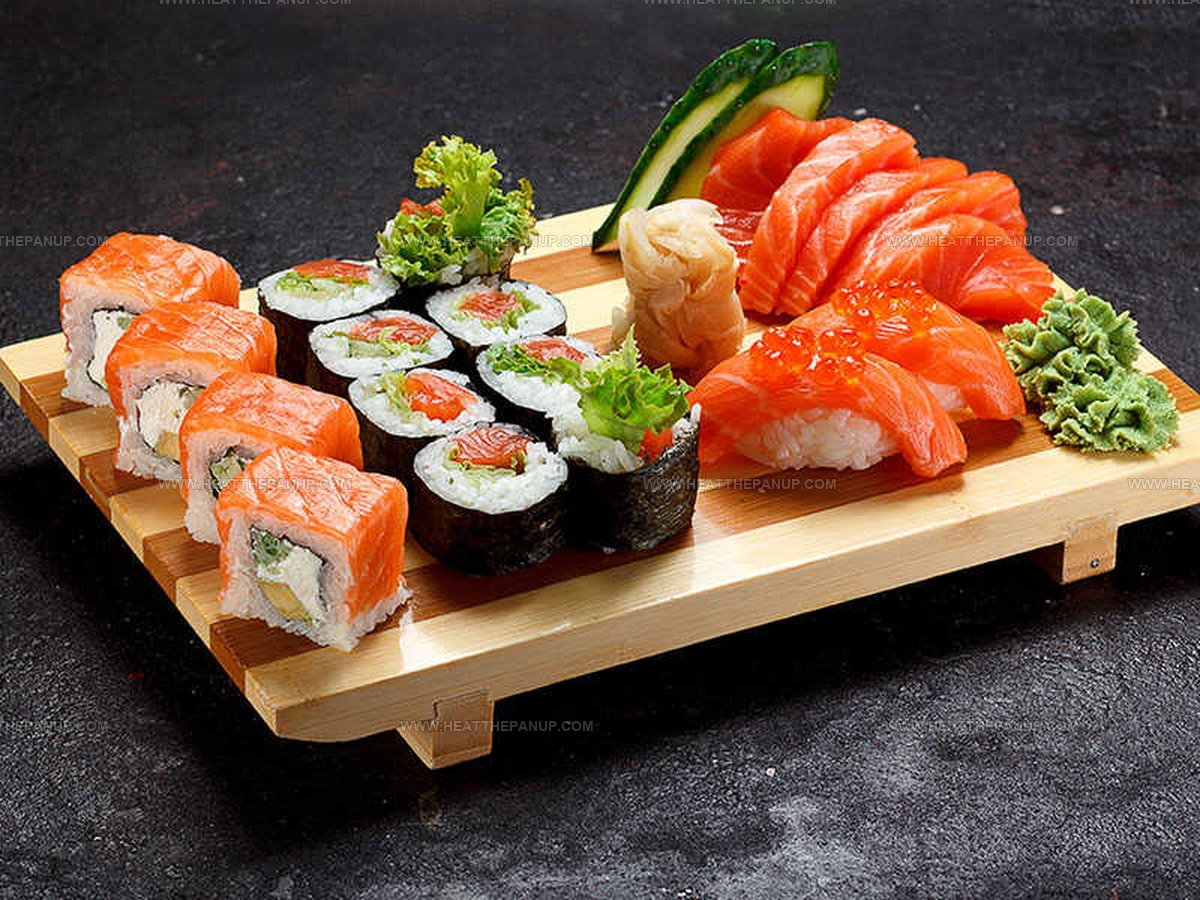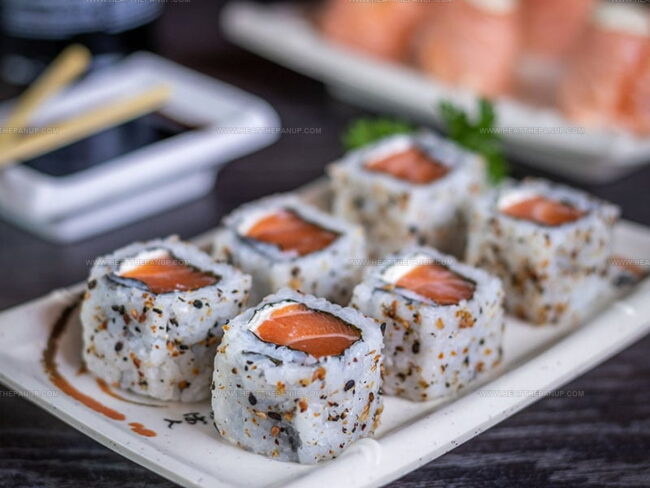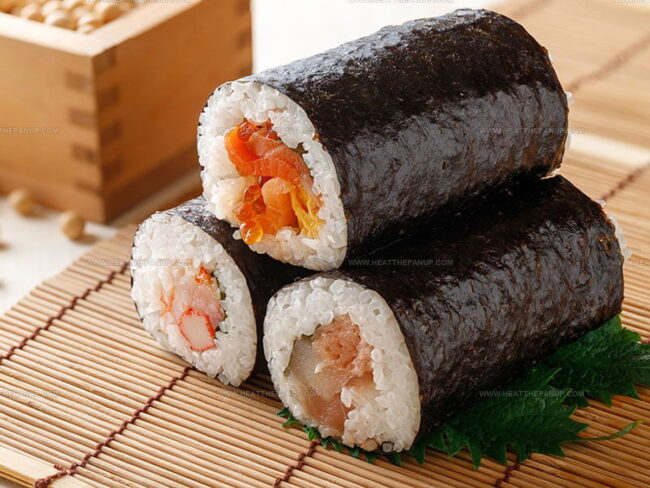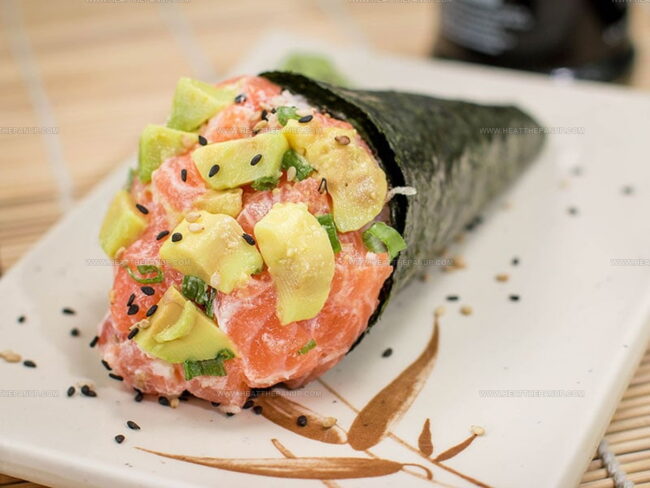Sushi Roll or Hand Roll: Know the Delicious Divide
Sushi rolls come in many delicious varieties, each with their own unique presentation and flavor profile.
Traditional maki rolls feature rice and fillings wrapped in seaweed, creating those familiar circular pieces seen at restaurants.
Hand rolls, on the other hand, resemble ice cream cones made of seaweed filled with similar ingredients but eaten immediately after preparation.
Most people recognize the cylindrical form of standard rolls cut into bite-sized pieces arranged artfully on plates.
Japanese cuisine enthusiasts often debate which style offers the better experience for enjoying fresh fish and vegetables.
Both options provide delightful ways to experience authentic flavors that have been perfected over centuries.
After reading more about these two popular sushi styles, you'll understand exactly which one to order next time.
Exploring The World of Sushi Rolls
Sushi rolls wrapped in dried seaweed are known by their Japanese name "maki." These popular rolls consist of rice and tasty fillings all bundled up in roasted nori sheets, then slicing them into perfect little rounds.
These classic rolls are actually the most traditional style of sushi you’ll find around the world, even if they’re sometimes just called “sushi rolls” on menus.
Whether you love simple cucumber rolls or adventurous combinations with fish, veggies, and sauces, maki sushi is a delightful and fun way to enjoy sushi. It’s all about rolling up fresh flavors into bite-sized happiness!
The History of Sushi Rolls
Japanese food historians trace maki sushi back to the Edo period during the 1700s before it spread throughout Japan in various forms. The name "makizushi" itself reveals its nature - "maki" means "to roll" in Japanese, and chefs typically use bamboo mats to shape these rolls before cutting them into smaller, bite-sized pieces.
Fast forward to the 20th century, sushi rolls crossed over to the West, especially the United States, where creative chefs began adding new fillings like avocado and cream cheese, giving rise to famous rolls like the California Roll.
Types Of Sushi Rolls
There are 5 popular types of maki sushi: Hosomaki, Chumaki, Futomaki, Temaki, and Uramaki. If you want a cool appetizer to start your party, these are great choices!
Each type differs in size, ingredients, and how it’s made. Here’s a quick guide to help you understand them:
Hosomaki
These are small rolls about 1 inch (2.5 cm) wide, made with vinegared rice and just one filling wrapped in seaweed. They’re the smallest and simplest sushi rolls.
Chumaki
Medium-sized rolls about 1 to 1.5 inches (2.5 to 3.8 cm) wide, with 2 or 3 fillings wrapped in seaweed. They’re bigger than hosomaki but smaller than futomaki.
Futomaki
Large rolls about 2 to 2.5 inches (5 to 6 cm) wide, with more than 2 fillings wrapped in seaweed. These rolls are hearty and packed with ingredients.
Temaki
Also called hand rolls, temaki are cone-shaped and about 4 inches (10 cm) long. They have rice and multiple fillings wrapped in seaweed, and you eat them with your hands.
Uramaki
Known as inside-out rolls, uramaki have seaweed wrapped around the fillings, but the rice is on the outside. These rolls didn’t start in Japan—they’re said to come from California, which is why some call them California rolls.
What Is Temaki?
Temaki sushi belongs to the maki family but stands out with its unique ice cream cone-like shape, typically measuring around 4 inches long. These hand-rolled treats feature vinegared rice and fillings wrapped in seaweed, creating an open-ended cone that's perfect for individual servings.
Unlike regular sushi rolls that can wait a while before eating, temaki should be enjoyed immediately after preparation because the rice quickly softens the seaweed, changing its texture. Since each temaki cone serves one person, they're never cut into smaller pieces like other sushi varieties.
Making temaki is quite simple as you roll them with your hands, but their substantial size means chopsticks won't work for eating them - these cones are definitely finger food!
The Origin of Temaki
Temaki has its roots in Japan as a casual and convenient way to enjoy sushi. Unlike traditional sushi that requires precise rolling and slicing, temaki is made by simply rolling vinegared rice and various fillings into a cone-shaped sheet of nori (seaweed) by hand.
Temaki likely developed as a practical solution for enjoying sushi on the go or at casual parties. Over time, its popularity spread beyond Japan, becoming a favorite worldwide for its simplicity, fun presentation, and versatility.
Dissimilarities Between Sushi Roll And Hand Roll
Sushi and hand rolls differ in several important ways that are worth knowing. A simple table below can help you remember these key differences quickly.
| Feature | Sushi Roll (Maki) | Hand Roll (Temaki) |
| Name | Maki Sushi (Sushi Roll) | Temaki (Hand Roll) |
| Type | Rolled sushi, cut into bite-sized pieces | Hand-rolled sushi, cone-shaped, not cut |
| Appearance | Cylindrical shape, made with bamboo mat | Conical shape, rolled by hand without tools |
| Rolling Method | Rolled tightly with a bamboo mat | Rolled freely by hand |
| Preparation | Often includes 5 types (hosomaki, futomaki, uramaki, etc.) with seaweed or rice outside | Always wrapped in seaweed, sometimes without rice |
| Ingredients | Vinegared rice with fish, seafood, veggies, eggs, fruits; usually cooked fish | Fish (usually raw), seafood, veggies, fruits, eggs; sometimes no rice |
| Consumption | Cut into 6-8 small pieces, eaten in one bite | Served whole, eaten in multiple bites |
| Sharing | Easily shared among several people | Meant for individual consumption |
| Eaten by | Can be eaten with hands or chopsticks | Usually eaten with hands due to size |
| Serving with | Served with soy sauce, pickled ginger, wasabi | Served with soy sauce, pickled ginger, wasabi |
| Availability | Common in sushi restaurants, supermarkets, convenience stores | Less common in restaurants; often homemade |
Appearance and Rolling Method
Maki sushi has that neat, cylindrical shape created by rolling ingredients tightly with a bamboo mat. This helps keep the sushi compact and easy to slice into even pieces.
Temaki looks a bit different with its cone-shaped roll made by hand, giving it a more casual and rustic feel. Since no bamboo mat is used, temaki is simpler to make and looks like a little sushi “ice cream cone” wrapped in seaweed.
Preparation and Ingredients
Preparing maki sushi involves layering vinegared rice with fillings like fish, veggies, eggs, or fruits on a sheet of nori or sometimes soy paper, then rolling it up tightly before slicing.
Temaki also uses nori but is always rolled by hand without slicing afterward. Temaki fillings can vary more freely, sometimes there’s rice, sometimes not, and often include raw fish or fresh veggies, making it a versatile and customizable option.
Consumption and Sharing
Maki sushi is typically cut into small, manageable pieces, perfect for sharing with friends or family. Each piece fits nicely in your mouth, making it great for group meals or parties.
Temaki comes as a single larger roll that you hold and eat with your hands, usually in two or three bites. Because of its size and shape, temaki is more suited for individual enjoyment rather than sharing.
How to Eat and Serving
You can eat maki sushi either with chopsticks or your hands, depending on what feels comfortable. The smaller pieces are easy to pick up and dip into soy sauce.
Temaki is best enjoyed with your hands because its size and shape make using chopsticks tricky. Both types of sushi are often served with classic condiments like soy sauce, pickled ginger, and wasabi to enhance their flavors.
Availability
Maki sushi is a staple on menus at nearly every sushi restaurant and is commonly found pre-packaged in supermarkets or convenience stores, making it easy to enjoy anytime.
Temaki isn’t as widely offered in restaurants since it’s simpler to make at home without special tools, but many people love making hand rolls themselves because they’re fun, quick, and customizable.
Similarities Between Sushi Roll And Hand Roll
Even though sushi rolls and hand rolls have their differences, they also share some great things in common, such as:
Pros and Cons of Eathing Sushi
Food choices come with their share of benefits and drawbacks for your health. Taking a moment to think about these effects can help you build a diet that keeps you feeling great without missing out on foods you enjoy.
Pros of Sushi
Sushi is generally a healthy choice with lots of benefits for your heart, brain, skin, muscles, and immune system. Here’s why:
Cons Of Sushi
While sushi has many health perks, there are a few things to keep in mind:
How to Make Sushi Rolls At Home
There are three classic ways to roll sushi. This section will show you how to make these wonderful sushi dishes with our simple instructions.
You also need to prepare these basic ingredients:
Classic Sushi Roll (Seaweed Outside)
Inside-Out Roll (Rice Outside)
Hand-Rolled Sushi (Temaki)
Ideal Sauces and Condiments to Pair with Sushi
If you are new to sushi, you should check out these ideal pairings to enjoy this Japanese delight at its finest.
Got Questions? We’ve Got Solutions
1. Is one easier to eat than the other?
Hand rolls are generally easier to eat because you can hold them directly in your hand. Sushi rolls typically require chopsticks and may fall apart if not picked up properly.
2. Which one has more rice?
Traditional sushi rolls contain more rice proportionally than hand rolls. Hand rolls often have less rice and more fillings, making them lower in carbs.
3. Can beginners make both at home?
Hand rolls are much easier for beginners to make at home since they don't require the tight rolling technique or bamboo mat needed for sushi rolls.
4. Which is better for large groups?
Sushi rolls are ideal for sharing since they're cut into 6-8 pieces, while hand rolls are individual servings meant to be eaten immediately by one person.





James Hambly
Founder & Recipe Creator
Expertise
Recipe Development, Culinary Education, Farm-to-Table Cooking, Southern Cuisine
Education
Asheville-Buncombe Technical Community College
Certificate in Culinary Arts
Focus: Hands-on training in professional cooking techniques, emphasizing farm-to-table practices and Southern cuisine.
The Chef’s Academy
Associate Degree in Culinary Arts
Focus: Comprehensive culinary education covering global cuisines, kitchen management, and food safety.
James grew up surrounded by the smells of cast-iron skillets and slow-cooked Southern meals in Asheville, North Carolina.
He sharpened his skills with a Certificate in Culinary Arts from Asheville-Buncombe Technical Community College, and later leveled up with an Associate Degree from The Chef’s Academy.
James’s philosophy is simple: the best meals don’t need fancy tricks, just fresh ingredients, a hot pan, and a little bit of heart. His favorite days are spent testing one-pan wonders, chasing bold flavors, and creating recipes that feel easy, even on a busy night.